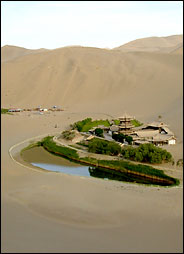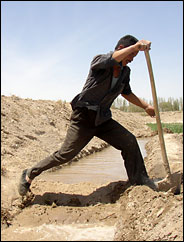| |


May 27, 2005
A Crescent of Water Is Slowly Sinking Into the Desert
By JIM YARDLEY
 |
 |
| Michael Zhao for The New
York Times |
| Crescent Lake, a tourist
attraction at Dunhuang in western China, has been shrinking
over the last three decades because of the falling water table.
(Click on picture for larger image.) |
|
 |
| Michael Zhao for The New
York Times |
| He Zhailin channeling water
from wells to irrigate his land. He tripled his farmland when
water was plentiful, but now it is drying up. (Click on picture
for larger image.) |
|
|
DUNHUANG, China, May 26 - At the bottom of the mountainous dunes once
traversed by traders and pilgrims on the ancient Silk Road, Wang Qixiang
stood with a camera draped around his neck. He was a modern-day pilgrim
of sorts, a tourist.
He and his wife had traveled by train more than 2,000 miles from eastern
China to the forbidding emptiness of the Gobi Desert to glimpse at a
famous pool of water known as Crescent Lake. They came because the lake
has been rapidly shrinking into the desert sand, and they feared it
might soon disappear. "It is a miracle of the desert," said Mr. Wang,
67.
In this desert oasis where East once met West and that is home to
one of the world's greatest shrines to Buddhism, the water is disappearing.
Crescent Lake has dropped more than 25 feet in the last three decades
while the underground water table elsewhere in the area has fallen by
as much as 35 feet.
An ancient city that once served as China's gateway to the West, Dunhuang
is now threatened by very modern demands. A dam built three decades
ago to help local farming, combined with a doubling of the population,
have overstressed a fragile desert hydrology that had been stable for
thousands of years.
"I would call it an ecological crisis," said Zhang Mingquan, a professor
at Lanzhou University who specializes in the region's hydrology. "The
problem is the human impact. People are overusing the amount of water
that the area can sustain."
Here as elsewhere in western China, the country's poorest region, the
emphasis in recent decades has been on economic development at all costs.
Isolated by the desert, Dunhuang has virtually no industry, so agriculture
has dominated the local economy. In the 1970's, the government dammed
the Dang River, which once flowed past the city, to provide better irrigation
for farmland and to help relieve poverty. Farming did improve, but in
a fashion that brought a larger burden: a desert oasis that had fewer
than 100,000 people before the dam now has roughly 180,000. As more
people arrived, the underground water table that is the city's main
source of drinking water started dropping.
The pressure now to preserve Dunhuang is amplified by the growing
recognition of the city's major cultural and historic significance.
The nearby Mogao Caves, painted with murals dating to the fourth century,
were built by the monks who helped bring Buddhism from India. The caves
have been designated as a World Heritage Site by the United Nations.
 |
 |
| The New York Times1
|
| Ancient gateway to the West,
Dunhuang faces new demands. |
|
 |
| Michael Zhao for The New
York Times |
| China dammed the Dang River,
which once ran past Dunhuang, in the 1970's, and as the area's
population rose, the water table has fallen. (Click on picture
for larger image.) |
|
|
The caves are a legacy of Dunhuang's emergence more than 2,000 years
ago during the Han Dynasty as a crucial entranceway into China by the
Silk Road, which served as the principal trade route to the West. Merchants
and pilgrims made the journey by following the string of oases that
skirted the brutal Taklamakan Desert, which many considered haunted
by demons and ghosts. "At times one can hear soughing, or sobbing, but
suddenly one does not know where to turn. ... Thus many perish," the
seventh-century Chinese monk Xuanzang wrote of the voices he heard in
the brutal heat. He described the desert as so bleak and empty that
travelers stacked up bones as landmarks.
Farming in Dunhuang also dates to the Han Dynasty, and among the tens
of thousands of manuscripts found inside the Mogao Caves was a map that
detailed the region's critical water sources. Now, in the village of
Zhabacha, about seven miles north of the city center, the water table
has dropped more than three feet in the past five years alone.
Beneath a midday sun on Tuesday that had driven other farmers into
their crumbling adobe homes, He Zhailin flooded a small plot of wheat
with irrigated water. Mr. He said that he tripled his amount of cultivated
land during the last decade and that some farmers had expanded even
more. Until recently, he said, government officials had encouraged farmers
to plant more crops. "There was a lot of water so the government encouraged
people to cultivate the land," recalled Mr. He, 40. "At the time, it
never dried up."
Now, local officials have introduced a strict policy known as the
"Three Forbids" that bans any new farmland, forbids new migrants from
moving to the city and prohibits any new wells. The need to protect
the underground water is magnified by the fact that almost 90 percent
of water from the Dang Reservoir is dedicated to agriculture.
Mr. Zhang, the Lanzhou University professor, stressed that reducing
consumption was the solution to the problem and noted that the supply
of glacial melt from the Qilian Mountains that feeds the Dang River
- and by extension the rest of the oasis - remained largely unchanged
from centuries ago. Even so, there are proposals to divert water from
a river in Tibet, though the likelihood of such a plan is far from certain.
Conservation has become particularly crucial because Dunhuang has
emerged as one of the leading tourist attractions in western China,
giving the city a veneer of prosperity rare in rural regions. Last year,
more than 430,000 tickets were sold to the Mogao Caves. In all likelihood,
even more people visited Crescent Lake, which is nestled in the picturesque
dunes known as the Singing Sands.
The lake, also a World Heritage Site, began shrinking in the 1970's
and is now about a third of its original size. In the 1990's, officials
tried pumping in water but quit because the transfers were polluting
the lake. More recently, reservoirs have been built a short distance
away in hopes that water would seep into the ground and help Crescent
Lake, also called Crescent Moon Lake and Crescent Spring.
"As local people, we are very worried," said Fan Cun, who heads the
agency overseeing the lake. "We would have failed future generations
if we watch this lake disappear."
Copyright
2005 The New York Times Company
|